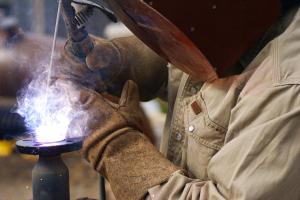
Metal fabricating refers to the art of adjusting the metal’s features and prototyping after a certain manufactured component is already produced. Metal fabrication is deemed to offer a much higher degree of flexibility and customization.
Main Benefits of Metal Fabrication
Metal fabricating includes a wide array of production techniques in order to produce value-added metal components. These metal components can be customized to the customer specifications; higher flexibility because of its capacity to rapidly execute design changes for a specific component part with very apparent cost profits; reduce lead times from the stage of designing the product to production; variety of very efficient and effective techniques in cutting raw sheet supplies to the right size including auto-feed saws and laser cutting. There are also other advantages of metal fabrication. Some of these originate from automatic lathes, palletized production feed systems, CNC machining centers as well as in machine tooling advancements which allows for precise surfaces as well as proficient production of high tolerances and pressed, stamped, machined and formed parts assembly which is usually accompanied with a quality check for alignment and accuracy with robotic welding and semi-automated welding processes which provides a much higher degree of accuracy and consistency.
There are also disadvantages with metal fabrication. The primary disadvantage seen in this kind of process is that it is a more labor intensive production which results in a higher cost in every unit; challenges in repeatability and consistency in comparison to a proven stamping die; slower rate of production compared to metal pressing and stamping and higher cost of materials; the deep drawn parts which aren’t usually viable with the metal fabrication techniques. Recognizing multi-level supplier which provides in-house support to a wide array of secondary operations which include thread rolling, forming, machining, welding, tapping and assembly will both reduce the overall costs and production lead times.
Metal Pressing and Stamping
Metal stamping is used widely in creating a wide range of components. Stamping or pressing involves a very efficient and cost effective means for medium to high volume production runs for different parts in order to reduce costs and increase incorporating secondary operations which produce unique product designs.
The key benefits when it comes to metal stamping and pressing is accuracy, speed as well as cost-efficiency in manufacturing certain complex products in medium to high volume of products. There is also an increased efficiency when you use highly automated coil-fed presses as well as in incorporating secondary operations within the press and die. The process enables you to allow value added operations like automatic stud or nut insertion, in-die welding and assembly, in-die tapping, enabling complex products as well as innovative designs to be created with repeatability and close tolerances which cannot be possibly done with fabrication techniques. The process of metal pressing and stamping also lowers the cost of metal as it is purchased in coil stock instead of sheet steel thereby less scrap is produced in the actual process of producing the material.







